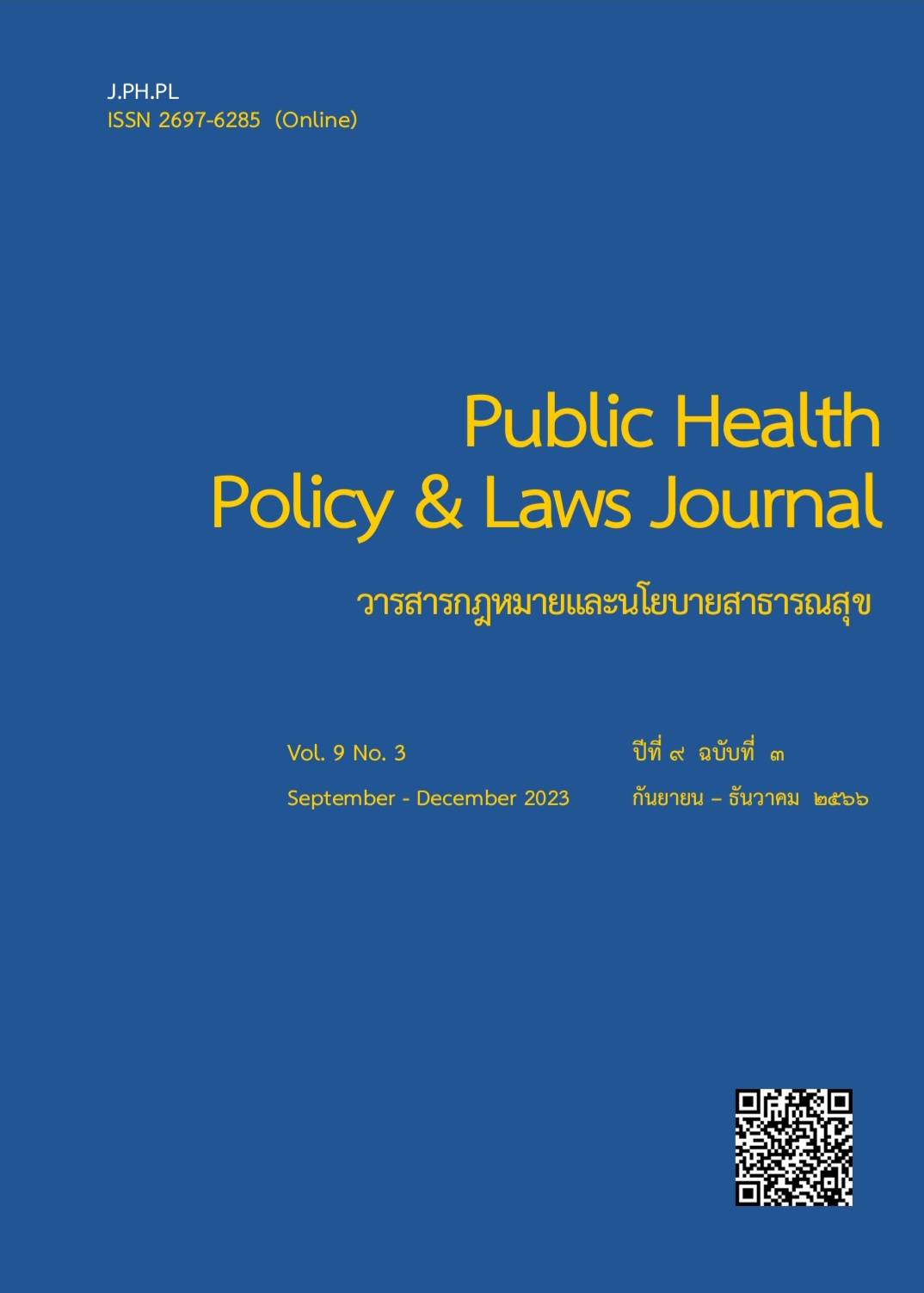Guideline for the diagnosis of compensable work-related post-traumatic stress disorder
Keywords:
Stress disorder/ Post-traumatic stress disorder/ Work-related/ Workmen compensationAbstract
Post-traumatic stress disorder affects people around the world. Particularly, employees in various occupational categories who are exposed to traumatic, or dangerous events, are at higher risk of post-traumatic stress disorder than general population. The objective of article is for the readers to understand diagnosis of post-traumatic stress disorder, and able to identify work-relatedness and compensability. Thailand has increasingly moved towards the industrial age. Notification of the Ministry of Labor, adding mental and behavioural disease including post-traumatic stress disorder, to the list of work-related disease in 2023. It is crucial to correctly diagnose post-traumatic stress disorder to ensure that employees are fairly compensated. Diagnosis requires cooperation from stakeholders, including employers, employees and physicians. The physician's job is to diagnose post-traumatic stress disorder, identify work-relatedness and compensability. Employers are required to be aware of employees’ symptoms while they are at work. Employees should be referred to a physician for additional assessment if suspected symptoms are discovered. However, post-traumatic stress disorder can affect all populations. Diagnosing work-related post-traumatic stress disorder is important. Physicians should know how to diagnose and make appropriate recommendations for employees.
References
Baloch, Q., Baloch, Q., Maher, S., Iqbal, N., Shah, S., & Hussain, M. (2021). Impact of Post Traumatic Stress Disorder on Employee Job Performance: Moderating Role of Spirituality. https://doi.org/10.21203/rs.3.rs-1180786/v1
Berger, W., Coutinho, E. S., Figueira, I., Marques-Portella, C., Luz, M. P., Neylan, T. C., Marmar, C. R., & Mendlowicz, M. V. (2012). Rescuers at risk: a systematic review and meta-regression analysis of the worldwide current prevalence and correlates of PTSD in rescue workers. Soc Psychiatry Psychiatr Epidemiol, 47(6), 1001-1011. https://doi.org/10.1007/s00127-011-0408-2
Blevins, C. A., Weathers, F. W., Davis, M. T., Witte, T. K., & Domino, J. L. (2015). The Posttraumatic Stress Disorder Checklist for DSM-5 (PCL-5): Development and Initial Psychometric Evaluation. J Trauma Stress, 28(6), 489-498. https://doi.org/10.1002/jts.22059
Chinvararak, C., Kerdcharoen, N., Pruttithavorn, W., Polruamngern, N., Asawaroekwisoot, T., Munsukpol, W., & Kirdchok, P. (2022). Mental health among healthcare workers during COVID-19 pandemic in Thailand. PLoS One, 17(5), e0268704.
Fischer, S., Schumacher, T., Knaevelsrud, C., Ehlert, U., & Schumacher, S. (2021). Genes and hormones of the hypothalamic-pituitary-adrenal axis in post-traumatic stress disorder. What is their role in symptom expression and treatment response? J Neural Transm (Vienna), 128(9), 1279-1286. https://doi.org/10.1007/s00702-021-02330-2
Hyland, P., Vallières, F., Cloitre, M., Ben-Ezra, M., Karatzias, T., Olff, M., Murphy, J., & Shevlin, M. (2021). Trauma, PTSD, and complex PTSD in the Republic of Ireland: prevalence, service use, comorbidity, and risk factors. Soc Psychiatry Psychiatr Epidemiol, 56(4), 649-658. https://doi.org/10.1007/s00127-020-01912-x
Kirkpatrick, H. A., & Heller, G. M. (2014). Post-traumatic stress disorder: theory and treatment update. Int J Psychiatry Med, 47(4), 337-346. https://doi.org/10.2190/PM.47.4.h
Lee, W., Lee, Y. R., Yoon, J. H., Lee, H. J., & Kang, M. Y. (2020). Occupational post-traumatic stress disorder: an updated systematic review. BMC Public Health, 20(1), 768. https://doi.org/1
1186/s12889-020-08903-2
Li, Y., Scherer, N., Felix, L., & Kuper, H. (2021). Prevalence of depression, anxiety, and post-traumatic stress disorder in health care workers during the COVID-19 pandemic: A systematic review and meta-analysis. PLoS One, 16(3), e0246454. https://doi.org/10.1371/journal.pone.0246454
North, C. S. (2018). PTSD: A systematic approach to diagnosis and treatment. https://cdn.mdedge.
com/files/s3fs-public/Document/March-2018/CP01704035.PDF.
Oakley, L. D., Kuo, W. C., Kowalkowski, J. A., & Park, W. (2021). Meta-Analysis of Cultural Influences in Trauma Exposure and PTSD Prevalence Rates. J Transcult Nurs, 32(4), 412-424. https://doi.org/10.1177/1043659621993909
Olivine, A. (2022). What Is Trauma?. https://www.verywellhealth.com/what-is-trauma-5212104.
Rothbaum, B. O., Foa, E. B., Riggs, D. S., Murdock, T., & Walsh, W. (1992). A prospective examination of post‐traumatic stress disorder in rape victims. Journal of Traumatic Stress, 5(3), 455-475.
Sareen, J., Stein, M., & Friedman, M. (2018). Posttraumatic stress disorder in adults: Epidemiology, pathophysiology, clinical manifestations, course, assessment, and diagnosis. Up to date [online].
Stewart, S. H., Pihl, R. O., Conrod, P. J., & Dongier, M. (1998). Functional associations among trauma, PTSD, and substance-related disorders. Addictive behaviors, 23(6), 797-812.
Watson, P. (2019). PTSD as a Public Mental Health Priority. Curr Psychiatry Rep, 21(7), 61. https://doi.org/10.1007/s11920-019-1032-1.
Yehuda, R. (2002). Post-traumatic stress disorder. New England journal of medicine, 346(2), 108-114.
Khamthong, C. (2021). Work-related post-traumatic stress disorder. Journal of Research and Innovation in Science and Technology, 2(1), 1-12.
Tantirangsi, N. (2023). Guidelines for caring for victims of traumatic events. http://www.thaiexplore.net/file_upload/submitter/file_doc/f80a6094d741022e964f7f445b22ea48.pdf.
Ministry of Labor. Notification of the Ministry of Labor on Specifying Types of Diseases Occurring by Nature or Conditions of Work or as a result of Work B.E. 2566 (2023). (B.E. 2566 (2023), 7th Febuary). Government Gazette Vol. 140, Special part 29d, Page 2-8.
Workmen's Compensation Act B.E. 2537 (1994). (B.E. 2537 (1994), 30th June). Government Gazette Vol. 111 Part 28a. Page 1-162.
Fahamnuayphon, P.. (2554). Shining "Disaster" B.E. 2554 (2011) with the impact on the health of Thai people. https://www.thaihealth.or.th/wp-content/uploads/2022/07/335.pdf.
Lortrakul, M.. (2015). Ramathibodi Psychiatry. (4th edition). Department of Psychiatry Faculty of Medicine Ramathibodi Hospital.
Social Security Office. (2019). Handbook for the insured to create a sustainable workforce society for all.https://www.sso.go.th/wpr/assets/upload/files_storage/sso_th/168d83800f111b11586c74980585901b.pdf.
Pholthanya, A. & Thongphaibul, K.. (2021). Psychological trauma: screening and assessment of affected persons for clinical psychologists. Thai Journal of Clinical Psychology, 52(1), 41-61. https://so03.tci- thaijo.org/ index.php/tci-thaijclinicpsy/article/view/252921
Downloads
Published
How to Cite
Issue
Section
License
Disclaimer and Copyright Notice
The content and information presented in articles published in the Journal of Law and Public Health Policy represent the opinions and sole responsibility of the respective authors. The editorial board does not necessarily agree with or assume any responsibility for the views expressed.
All articles, data, content, images, and other materials published in the Journal of Law and Public Health Policy are the intellectual property of the journal. Any individual or organization wishing to reproduce, distribute, or otherwise use the entirety or any part of such materials must provide proper citation.





